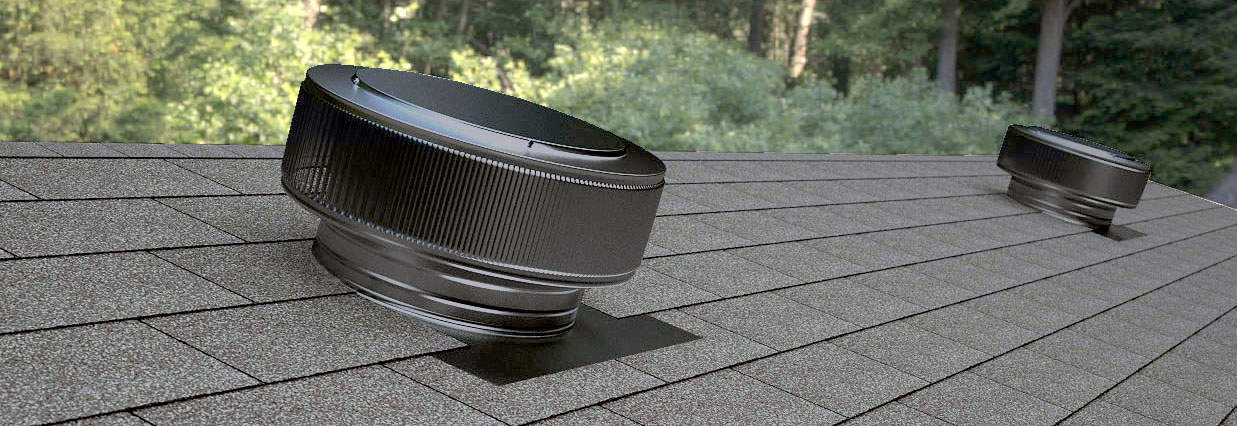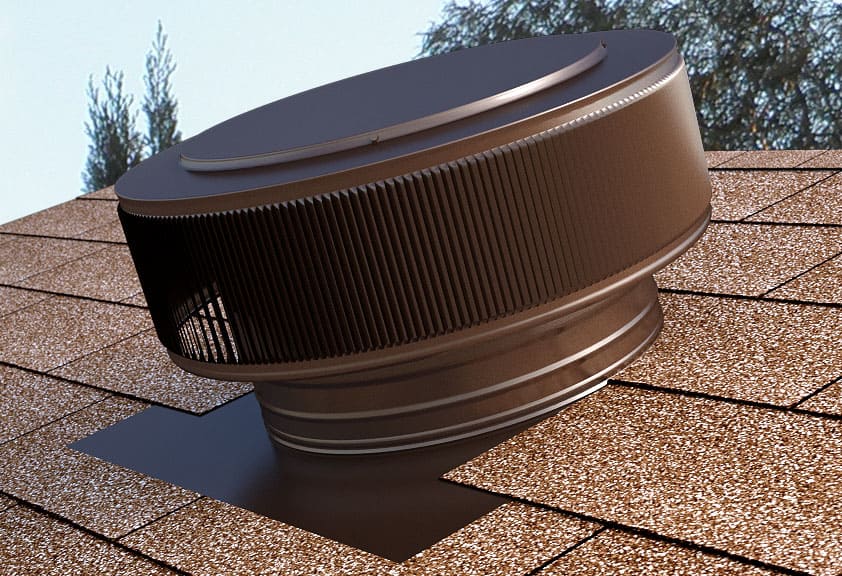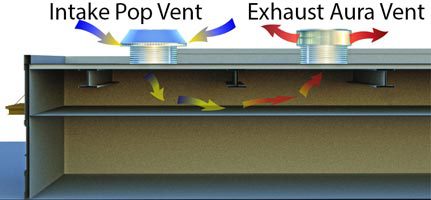
An attic ventilation system consists of a balance between exhaust vents and intake vents. Together, this will create a ventilation system that helps to reduce attic temperature and excess moisture.
Intake vents should be near the bottom of the roof and are a very important part of attic ventilation. These vents allow fresh air from into the attic. If there's no air coming in, then no air can flow out. As a result, this will reduce the effectiveness of the attic ventilation system and potentially cause roof system degradation.
This air circulation will continually flow through the attic and then back outside through exhaust vents. Exhaust vents should be placed near the peak of the roof to allow hot air to escape. The vents help protect the roof system from the inside out. It's important that the amount of exhaust ventilation near the ridge does not exceed the intake air ventilation at or near the soffit.
Pop Vent
There are two types of intake vents: soffit vents and rooftop intake vents. Most homes have soffit vents if they are constructed with roof overhangs or eaves. The soffits are typically located at the lowest point of the roof. This makes it the perfect spot for fresh air to enter the attic. Soffit vents come in various styles, including individual vents, continuous strips, and ventilated soffit panels.
Homes with limited or no soffits can use rooftop intake vents, which do not require homeowners to build expensive new soffits or alter existing ones. At AVP, we offer an array of sizes and heights of intake vents with both flat and curb mount flanges. This allows for every customer to be able to find the perfect vent for their home. In addition, this allows for installation in every climate zone across the US.

Aura Gravity Vent
Exhaust ventilation is most efficient when it's installed near the highest point of your roof. The allows for hot, humid air to easily escape. At AVP, we offer a few different types of exhaust ventilation.
Since they make use of the natural flow of air as hot air rises, AVP's Gravity Exhaust Vents do not require electricity. Instead, they rely on the Venturi Effect when the wind blows against the outer louvers. As a result, this creates an upward draft allowing air to freely flow in and out of the vent. Even the smallest breeze can create exhaust ventilation so that air is drawn out of the gravity vent. This allows the vent to remove heat from the attic in the summer and in the winter.
The Round Back Static Vent is one of the smallest roof vents AVP uses for steep slope roof ventilation; however, it's also one of the most popular roof vents AVP manufacturers. Don’t let the compact size fool you, this static vent is a great choice for ventilating attic spaces. When installed near the peak of the roof, this static vent will exhaust hot air from the attic in the summer and moisture from the attic air in the winter.
The Aura Attic Fan exhausts air for proper attic ventilation. This fan will exhaust air continuously even when the motor is off. It also works passively because of the Venturi Effect. This occurs when the wind blows against the outer louver to create an upward draft. As a result, allowing air to freely flow in and out. Aura Attic Fans remove hot humid air during the summer and moist damp air during the winter. This not only keeps the insulation dry but will lengthen the life of the roof.
Aura Attic Fans have vertical louvers that prevent rain and snow from entering. These louvers also keep out insects and animals. As a result, this keeps the fan clean which allows maximum air exhaustion without resistance. In addition, this fan has a removable top which makes it easy for maintenance on the unit.
The Aura Fan is available with a Curb Mount Flange for easy installation on a Roof Curb.

Attic Ventilation System
Every home is different. The best vents for your roof will depend on your home's architectural style, the design of your roof, and your local climate. It's important not to mix different types of exhaust vents in the same attic space, which can prevent proper airflow through the space. See AVP's climate zone chart to determine proper collar height for your area. If you are looking to determine the pitch of your roof, our roof pitch diagram may help.
For any questions please see the frequently asked questions page. If you still have questions, email the sales team at [email protected] or call 845-565-7770.